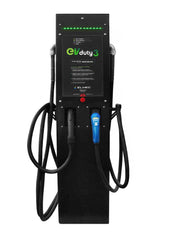Why is fast charging sometimes less fast?
Charging speed, which is the number of kilometers of range added per hour of charging, can vary quite a bit when charging your electric vehicle at a DCFC1. Charging speed depends on the power provided by a charging station, and the factors that influence this power are almost always related to the vehicle parameters. Thus, apart from the station’s rated power limit, it is very rare that a reduced charging speed is caused by a defect of the charging station. But then, what makes fast charging at times less fast?
BATTERY TEMPERATURE
![]() To avoid or limit battery degradation, the vehicle’s programming causes charging speed to be reduced if the battery is too hot (situation observed mainly in summer) or too cold (situation encountered especially in winter). Here is what impacts the temperature of an electric vehicle’s battery:
To avoid or limit battery degradation, the vehicle’s programming causes charging speed to be reduced if the battery is too hot (situation observed mainly in summer) or too cold (situation encountered especially in winter). Here is what impacts the temperature of an electric vehicle’s battery:
- Battery temperature is of course affected by ambient temperature (warmer in summer, colder in winter).
- Battery temperature rises while the vehicle is in use: acceleration, highway speeds and regenerative braking all heat up the battery.
- Fast charging heats up the battery and, to a lesser extent, so does 240V charging.
- A battery with a temperature control system stays closer to optimal temperatures.
BATTERY CHARGE LEVEL
![]() Throughout a fast charging session, the charge level will also affect charging speed. Generally, the closer the charge level gets to 80%, the more limited the charging speed becomes. We can compare this phenomenon to filling a glass of water: at first, you turn on the tap fully then, to avoid overflowing, as the glass gets fuller you reduce the water flow. This being said, programming varies a lot from one brand to another, so the impact of battery charge level is greater in some vehicles.
Throughout a fast charging session, the charge level will also affect charging speed. Generally, the closer the charge level gets to 80%, the more limited the charging speed becomes. We can compare this phenomenon to filling a glass of water: at first, you turn on the tap fully then, to avoid overflowing, as the glass gets fuller you reduce the water flow. This being said, programming varies a lot from one brand to another, so the impact of battery charge level is greater in some vehicles.
OPTIMIZE THE EFFECTIVENESS OF YOUR FAST CHARGING SESSIONS
By better knowing theses charging speed limiting conditions, you can optimize the effectiveness of your charging sessions by applying some tips:
- Use a 240V charging station to charge at home and schedule the session to end just before you leave, especially in winter.
- When charging on a DCFC, avoid charging beyond 80% unless it is absolutely necessary to reach your destination or get to the next charging station.
- On the road, especially in winter, start charging upon arriving at your destination while the battery is still warm. In summer, for some vehicles and when possible, it might be preferable to let the battery cool down before charging, especially if it does not have a thermoregulation system.
Nonetheless, even if you apply these tips, your fast charging sessions will usually be slower in winter, especially in severe cold. Thus, plan your trips accordingly.

1 DCFC: DC fast charging station, sometimes also called a fast charging station. Technical characteristics: power generally of 50kW delivered through current of 400 VDC and 125A.

Leave a comment